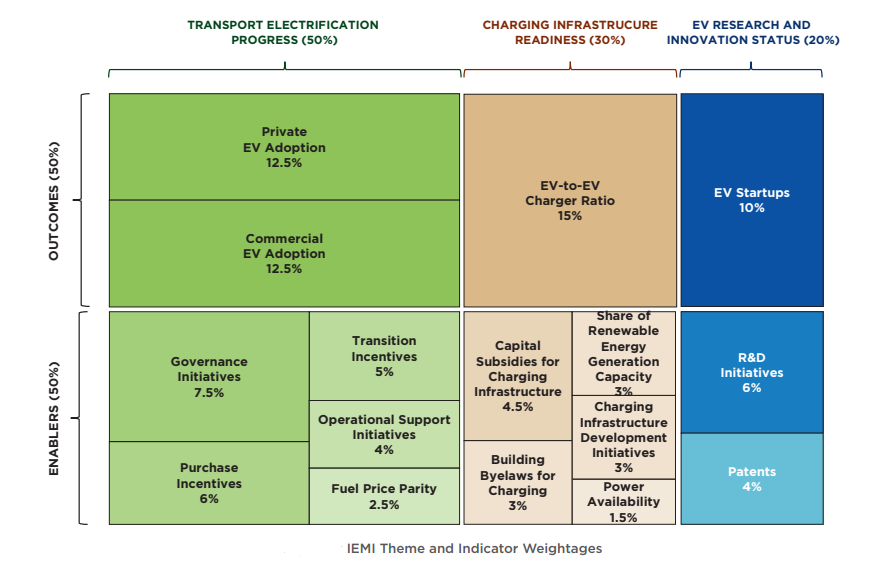Facts for UPSC Mains
India Electric Mobility Index and EVs in India
- 05 Aug 2025
- 5 min read
Source: PIB
Why in News?
NITI Aayog launched the India Electric Mobility Index (IEMI) along with its report titled ‘Unlocking a 200 Billion Dollar Opportunity: Electric Vehicles in India’.
What is India Electric Mobility Index (IEMI)?
- About: The IEMI tracks and evaluates the progress of Indian States and Union territories (UTs) in achieving their electric mobility goals.
- Core Themes: The IEMI uses 16 indicators under the three themes to assess performance.
- Transport Electrification Progress: Measures the adoption of electric vehicles and demand-side factors.
- Charging Infrastructure Readiness: Assesses the development and availability of EV charging stations and related infrastructure.
- EV Research and Innovation Status: Tracks R&D efforts, patents, and innovation in the EV sector.
- The IEMI score is a composite score on a 0-100 scale reflecting a state’s performance in developing the e-mobility ecosystem.
- IEMI 2024:
- Frontrunners (Score: 65-99): Delhi, Maharashtra, Chandigarh.
- Performers (Score: 50-64): Karnataka, Tamil Nadu, Haryana.
- Aspirants (Score: 0-49): States and UTs like Odisha, Rajasthan, Uttar Pradesh, Ladakh, Andhra Pradesh, and others are lagging in their e-mobility initiatives and require targeted interventions.
- Impact on Policy: The IEMI offers a comparative framework for states to benchmark progress, identify gaps, and learn from each other.
- It fosters healthy competition and supports evidence-based policymaking, allowing states to tailor their electric mobility strategies using data-driven insights and best practices.
What are the Key Highlights of NITI Aayog Report on Electric Vehicles in India?
- India's EV share was one-fifth of global levels in 2020, now at over two-fifths in 2024.
- India must now increase EV share by 22% in just 5 years to meet its 2030 goal (30% EV penetration by 2030 under the EV30@30 campaign)
- Manufacturing capacity has expanded through schemes like the PLI Scheme and National Programme on Advanced Chemistry Cell (ACC) Battery Storage.
- EVs in India: According to the NITI Aayog report "Unlocking a 200 Billion Dollar Opportunity: Electric Vehicles in India", EV penetration rate in India increased from 0.23% in 2016 to 7.6% in 2024. In comparison, the global EV penetration rate grew from 3.08% to 16.48% in the same period.
- Government Initiatives: Electric Mobility Promotion Scheme 2024, FAME-II (Faster Adoption & Manufacturing of Electric Vehicles in India) and PM Electric Drive Revolution in Innovative Vehicle Enhancement (PM E-DRIVE) have supported EV adoption, charging infrastructure, and manufacturing capacity.
- Challenges: Financing issues, especially for procurement of electric buses and electric trucks.
- Inadequate charging infrastructure and low utilization of existing public charging facilities.
- Lack of awareness regarding EV performance. Data and regulatory gaps hinder evidence-based decision-making.
- Recommendations: Implement a clear policy with timelines for Zero Emission Vehicle (ZEV) adoption, expand Corporate Average Fuel Efficiency (CAFE) norms, and disincentivize Internal Combustion Engine (ICE) vehicles.
- Instead of spreading efforts thinly, focus on saturating 5 cities with EVs, with a gradual then expansion to 100 cities. Involve state-level entities to manage and coordinate the program effectively.
- Create a pooled fund for e-buses and e-trucks, identify high-density corridors of EVs and establish charging hubs, and promote battery leasing along with leasing industries for EVs.
|
Drishti Mains Question: Q. India aims for 30% electric vehicle penetration by 2030. What are the major barriers to achieving this goal and suggest targeted policy interventions. |
UPSC Civil Services Examination, Previous Year Question (PYQ)MainsQ. The adoption of electric vehicles is rapidly growing worldwide. How do electric vehicles contribute to reducing carbon emissions and what are the key benefits they offer compared to traditional combustion engine vehicles? (2023) |







